Trees Threatened with Destruction by UC Berkeley
Click on an image to see the high-resolution uncropped version.
In some browsers you can click near the first image and then TAB to subsequent images.
UC Berkeley is planning a major tree cut and ongoing herbicide applications in Strawberry Canyon and Claremonet Canyon in Oakland, as part of a much broader FEMA-funded cut throughout the East Bay. Here are photos of some of the Monterey pine (Pinus radiata) and blue gum eucalyptus (Eucalyptus globulus) trees on UC land that are threatened with destruction, along with narration from a talk. These trees have been damned on the unfounded premise that "non-native" trees are more of a fire hazard. Also included toward the end are Monterey cypress trees (Hesperocyparis macrocarpa) that have not been named as targets (to my knowledge), because like the pines they were brought in at around the same time from the same distant lands (the Monterey Peninsula) and so perhaps would end up under the knife as well.
Groups opposing the plan include Save the East Bay Hills, Death of a Million Trees, the Hills Conservation Network, the TreeSpirit Project, the Coalition to Defend East Bay Forests, East Bay Pesticide Alert, and CUIDO (Communities United in Defense of Olmstead). See also FEMA's web pages, especially the FAQ. For photos of vegetation near Signpost 29 on Claremont Avenue, where eucs were already cut years ago, see bapd.org/sign29.html.
For an outline of arguments against the cuts, see bapd.org/treenotes.html.
Sign petitions against the cut at MoveOn and at Care2.
These photos by Ken Cheetham are free for any not-for-profit use. For more of my photos in this special area, see my longer sequence.
 130623 01 eucalyptus on lower Stonewall-Panoramic Trail (threatened by UC) | If you head up the popular Stonewall-Panoramic Trail, either from near the Claremont resort or from the Clark-Kerr UC campus, you'll pass lots of eucalyptus along the way. This first part of the trip is in the Claremont Canyon Regional Preserve, and so the East Bay Regional Park District will decide the fate of the eucalyptus here. |
 130623 02 eucalyptus on first Stonewall-Panoramic landing | Here's a special fat euc on the first landing. And just beyond those two people ... |
-small.jpg) 090531 09 hollow eucalyptus on lower Panoramic Trail knob (now gone) | ... we have a hollow euc, where now and then I've seen a person studying inside there, though that particular tree ... |
 150703 20 the big hollow eucalyptus is now gone | ... is now gone. Maybe that one tree was diseased or about to fall, but all of them may have a similar fate in store. Jumping ahead, if you make it to the top of this sometimes steep trail, you will find yourself ... |
 100131 09 pines on the way to poppy knob (threatened by UC) | ... on Panoramic Ridge, where the rest of the trees that I'll show today are on UC Berkeley land. The trees along the side here (except for that one euc in the back) are Monterey pines, which are explicitly targeted for removal just like the eucalyptus. Often the pines are in nice groves like ... |
 100404 09 Pinus radiata on the ridge (threatened by UC) | ... this one. This is looking to the north from the ridge into Hamilton Gulch, and the tall trees here are all Pinus radiata, or Monterey pines. Now, you may be hearing the word "thinning" being bandied about nowadays, and think they're no longer going to cut that many trees. But that word "thinning" comes from the December 2014 revision to the FEMA Environmental Impact Statement, after lots of critical public comment. And that document clearly states that while the new thinning approach will result in fewer trees removed in any single year, by the end of the project it will still result in "the same total fuels reduction". Where of course "fuels reduction" mostly means "tree destruction". So apparently they do still intend to take out all, or nearly all, of the eucalyptus and pines as in the original proposal, though it will now be stretched out over several years or more. |
 110313 01 Pinus radiata on the first connector (threatened by UC) | Here are some more pines on a connector trail. And the next shot will be looking straight up these same trees ... |
 130623 09 straight up Pinus radiata in the fog (threatened by UC) | ... in the fog. Tall trees reach fog that's out of reach for other plants, thereby increasing the amount of fog drip that keeps more moisture in the area, and also puts some water in the creeks even in a dry summer. Yet some people are itching to destroy these trees as insidious invaders, though the trees have been here longer than those people. And this brings us to: |
 090722 10 pine tree bark and knot (threatened by UC) | Bark! Trees have thick bark that insulate them from fire, one of the main things that make trees relatively fire-resistant. |
 090822 21 bluish-gray pine tree bark (threatened by UC) | And a nice side effect of bark is that it comes in ... |
 101224 09 red Pinus radiata bark up close (threatened by UC) | ... a wonderful variety of pleasing colors and patterns. |
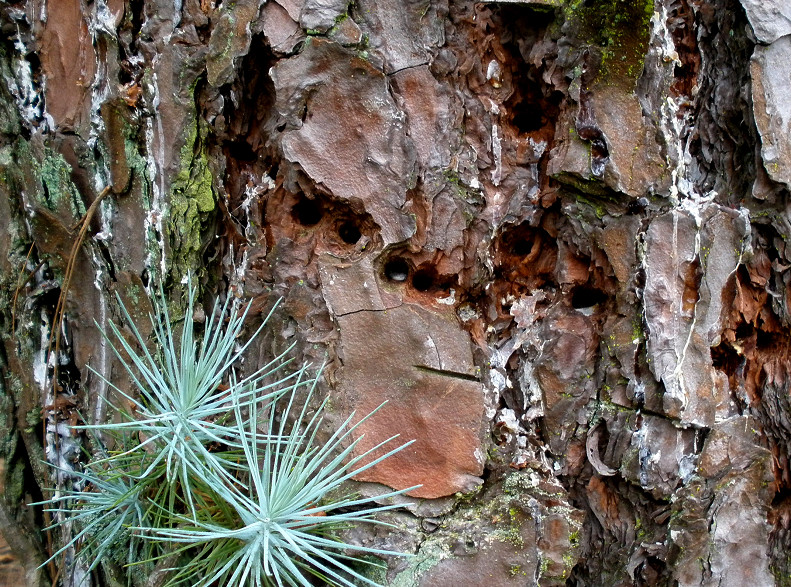 090819 20 holes in pine bark at first connector trail (threatened by UC) | Apparently a woodpecker has visited this tree. |
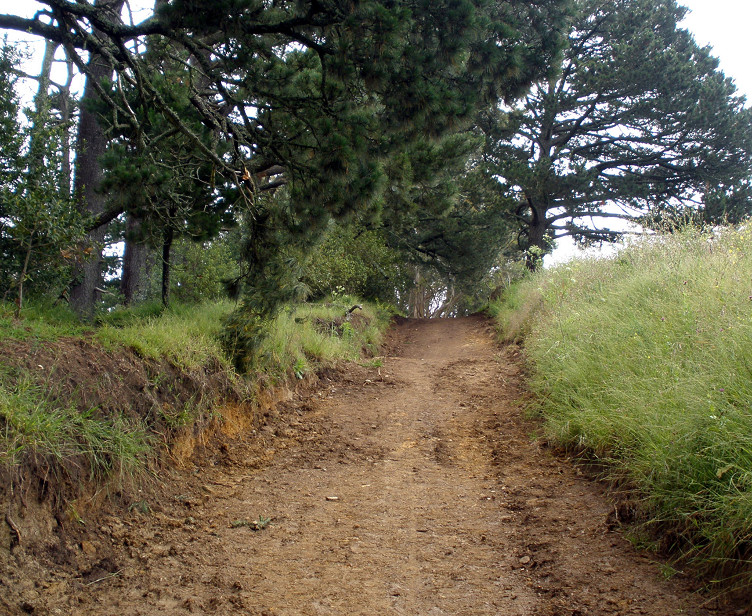 090531 22 climbing under the pines to poppy knob (threatened by UC) | Now back on the ridge as we climb a hill under the pines. |
 090822 19 southward pine branches beyond lichen (threatened by UC) | If you look back down this hill, it looks like the pines are growing their limbs toward the south only, to reach across the ridge toward the sun. |
 091213 15 southward pine limbs in foggy rain | This bay on the left may be enjoying some fog drip from those same pines. |
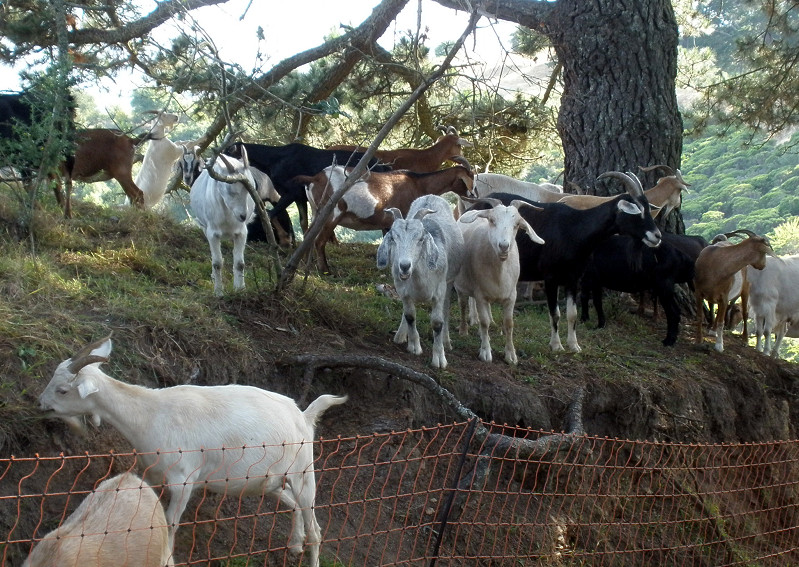 090614 19 goats near tree on poppy knob | Here were some goats right there one day, employed to clear ground vegetation, another less destructive tool to add to the mix. |
 100314 02 pines on the ridge trail from poppy knob (threatened by UC) | And here's looking back along the ridge at the first cypress and pine groves, with Claremont Canyon on the left. |
 140302 08 eucalyptus not yet destroyed by UC (threatened by UC) | On this same hilltop we meet some more eucalyptus. I took this shot shortly after some rain, which I like to do because of the vivid colors, here showing how eucalyptus has its own nice blend of colors in its bark. |
-small.jpg) 110911 05 blue gum eucalyptus leaves (Eucalyptus globulus) (threatened by UC) | I think these are younger eucalyptus leaves. They do in fact have a High Oil Content, similar to lots of other plants, such as California bay laurel and various California chaparral brush plants. |
 140302 09 eucalyptus not yet destroyed by UC (threatened by UC) | More eucs after the rain. I get the feeling that eucalyptus is simply not "tidy" enough for some people. If they can't use a comb, then chop 'em down. And one rationale that's given for destroying the eucs is that they shed so much litter, ... |
 091227 14 eucalyptus bark in California bay laurel | ... famously including their bark, that "nothing else can grow anywhere near them", as you can see. |
 100110 11 eucalyptus behind California bay laurel | But in fact California bay laurel in particular mingles with the eucs ... |
 100103 12 eucalyptus surrounded by CA bay laurel | ... throughout the area. It's easy to find examples of this. And sometimes ... |
 110629 19 CA bay laurel leaves by eucalyptus trunk | ... they're cute together! |
 090718 30 eucalyptus and bay laurel grove by Claremont Trail (threatened by UC) | Even in this dense eucalyptus grove, which is just above Claremont Avenue in Claremont Canyon, though on UC Berkeley land. From here it looks like nothing else could grow in there. But if you go into that grove ... |
 150703 10 California bay laurel mingling with eucalyptus | ... you'll see bay trees all around. A Sierra Club position paper on the tree cuts says that California bay laurel is, quote "struggling to survive", unquote, below taller trees that won't let it reach its full size. But this plant exists at different sizes and in different forms in different places, because it's versatile. I don't see it "struggling" anyhwere. I see it co-existing here with the eucalyptus ... |
-small.jpg) 150703 14 California bay laurel amidst tall pines (closer) | ... just as it does with the tall pines, here in a larger tree form itself, ... |
 100131 10 cypress trees behind CA bay laurel | ... and as it does under the cypress trees in a smaller shrub form (as it withers away here). And there's lots of other co-existing going on between the officially native species and these tall trees, such as ... |
 150703 19 sticky monkey flower beneath pines | ... sticky monkeyflower growing below these pines, and I found ... |
-small.jpg) 090920 12 California blackberry (Rubus ursinus) | ... this California blackberry in the middle of a pine grove, if you can take my word on this one. On the other hand ... |
 110629 20 broom and hemlock encroach on Side Hill Trail | French broom and poison hemlock are very good at quickly moving into any space that's been cleared, especially in sunny spots that they prefer, as when tree cover is removed. So if we create a lot more of ... |
 130623 14 20,000 more of these are on the way | ... these (this pine apparently was too close to the fire trail), then we may end up with a lot more of the broom and hemlock jumping in to fill the void around the stumps, before any of the new trees that are not being planted or even chaparral scrub can take root there. They could repeatedly hand-paint stumps with herbicides as they propose (the FEMA doc says twice a year) AND cut back any addtional broom and hemlock around the stumps, or they could simply pull out litter that accumulates on the ground, maybe every few years, which they say would somehow be much more expensive. |
 100207 03 cypress trees on top-of-Panoramic knob | Monterey cypress are not mentioned as a target species, as far as I know, though they're very similar to the pines in that they're both tall coniferous trees that were brought over from the Monterey Peninsula at the same time over a century ago, so I have to wonder if they'll end up in trouble as well. |
 110629 04 down into cypress trees below Lower Jordan | So I'd like to point out that the cypress groves are among the most pleasant spots. The cypress and redwood groves are the only places where I never see poison oak, and in the cypress groves there's always this nice grass that's green the whole year round, presumably from the fog drip and shade that tall trees provide. The 1991 firestorm started in DRY grass, in a RESIDENTIAL area, yet ostensibly to avoid a another tragic residential fire, somehow they're targeting the tall moisture-retaining trees - in - the forests! Maybe due to too much ideology in that decision. |
 091213 09 cypress trees in foggy rain behind California bay laurel | Do we really want to take the fog drip away from this happy-to-be-a-shrub California bay? |

110130 02 a CA bay laurel beneath the cypress
 090531 19 pines behind Panoramic Ridge cypress trees (threatened by UC) | Wrapping things up: WILL these cypress trees end up targeted like their pine cousins in the distance here, as some organizations insist? |
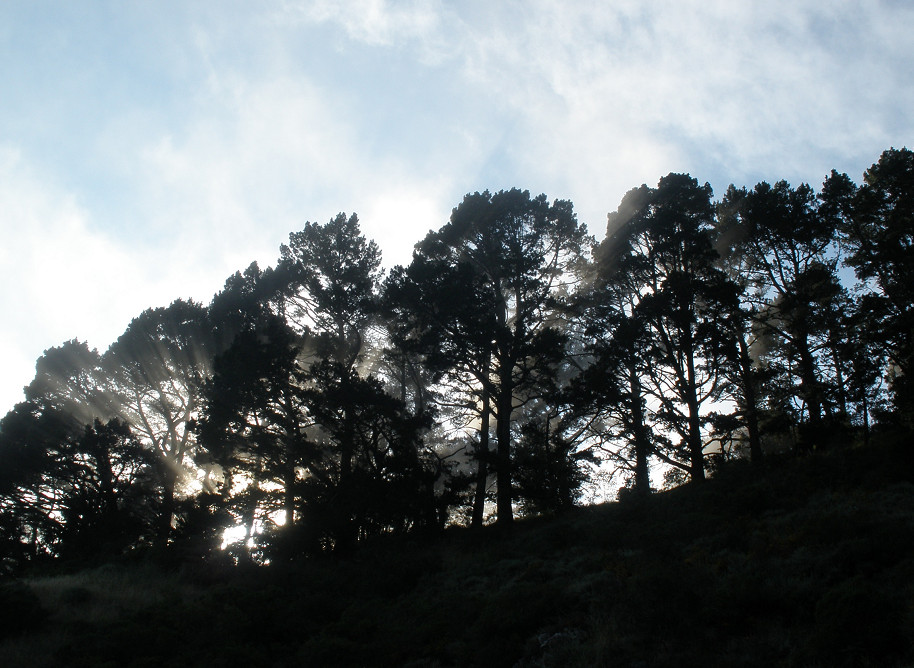 090528 78 foggy ridge trees near Grizzly Peak Boulevard | WILL these pines up on Chaparral Peak, the highest point on this trail, be mowed down? |
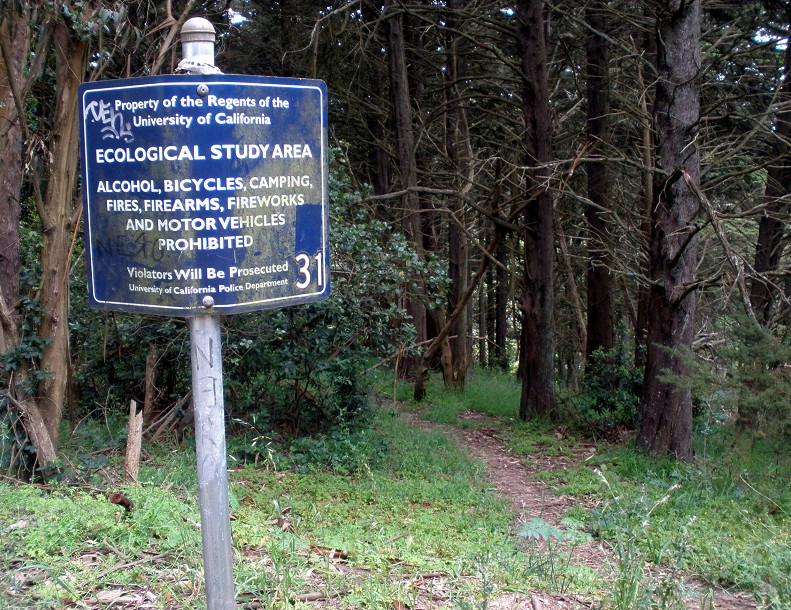 090610 25 start of path to twixt-hamil-straw knob | And WILL this whole area be turned into more of a Herbicide Study Area? (Now look here! Herbicides are just fine here, BUT [wagging finger] NO ALCOHOL! It's too risky. You might spill some alcohol on a tree stump and wash the herbicides off!) OR -- |
 120408 01 cypress on ridge beyond young pines (threatened by UC) | OR - Will the pines and other tall trees simply be allowed to live. And to regenerate themseleves as they're doing here. OK, I have two more photos; [peace sign] two more photos and I'm done. |
 110407 09 trails below silver lupines on spiral knob | These last two are taken from spiral knob, which is the best lookout point along Panoramic Ridge. This one looks back along the ridge trail on the left, with Claremont Canyon to the left of it, and the Upper Jordan trail on the right in Hamilton Gulch. The trees between these two trails are largely pines, cypress, and eucalyptus, and so most of those trees are in danger. Here you can see them just reaching some fog that ground plants would not be reaching. And now stepping backwards maybe 15 feet from this photo for my final offering: |
 090610 34 cloudy Golden Gate behind lower spiral | Here's the Golden Gate beyond the eternal spiral, with some beloved-by-me California sagebrush on the left. The sagebrush is famous for being very aromatic due to its - wait for it - High Oil Content, like the eucalyptus. But notice the dark tree line in the middle ground -- that's basically pine trees going down that long slope toward the UC Botanical Garden, with maybe some eucalyptus in there too. So that tall tree skyline may be going away. UNLESS -- we don't let 'em get away with it. |